Recent Posts
The Benefits of Professional Upholstery Cleaning After a Fire: Expert Insights from SERVPRO
12/18/2024 (Permalink)
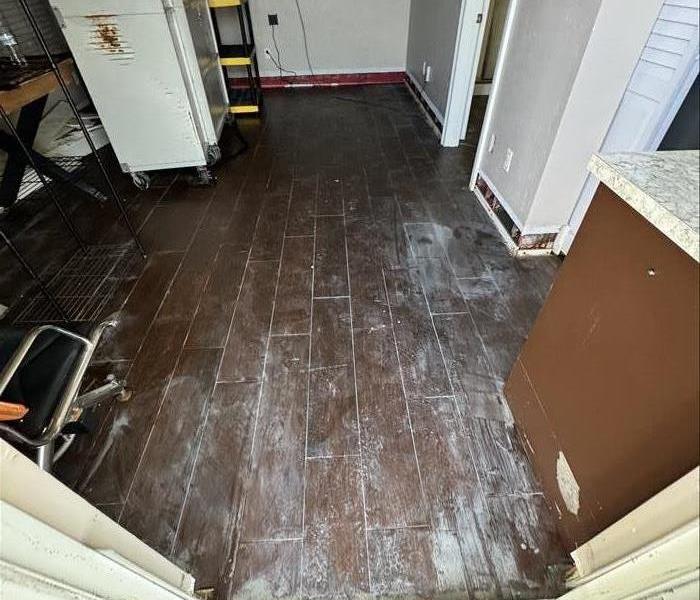 Explore the benefits of professional upholstery cleaning after a fire and why it’s essential for your home’s recovery.
Explore the benefits of professional upholstery cleaning after a fire and why it’s essential for your home’s recovery.
After a fire, the visible damage to furniture, walls, and flooring is often the first thing homeowners notice. However, less visible elements, like upholstery, can also suffer significant smoke, soot, and debris damage. Cleaning upholstery after a fire is a crucial part of the restoration process, and SERVPRO® offers expert services designed to restore your furniture to its pre-fire condition. In this blog, we’ll explore the benefits of professional upholstery cleaning after a fire and why it’s essential for your home’s recovery.
Why Professional Upholstery Cleaning is Necessary After a Fire
Fires leave behind more than just burnt materials. Soot, smoke, and ash can penetrate deep into upholstery fibers, causing lasting damage if not properly cleaned. If upholstery isn’t treated promptly, smoke odors can become embedded in the fabric, and soot particles can lead to discoloration and degradation of the materials. While surface cleaning may remove some visible signs of damage, it’s often insufficient to address deep-set contamination, which is why professional upholstery cleaning is essential.
According to the National Fire Protection Association (NFPA), U.S. fire departments responded to over 353,000 residential structure fires in 2021, causing billions in property damage. Professional cleaning services, like those provided by SERVPRO, play a key role in the restoration process following such incidents.
The Benefits of Professional Upholstery Cleaning After a Fire
1. Thorough Soot and Smoke Removal
One of the most significant benefits of professional upholstery cleaning is the removal of deep-seated soot and smoke. Upholstery fibers are porous, meaning they can trap tiny particles left behind by fire. SERVPRO technicians use specialized equipment, such as high-powered vacuums and professional-grade cleaning agents, to extract soot and smoke from deep within the fabric. This process ensures your upholstery is thoroughly cleaned, preventing lingering odors and discoloration.
2. Restoration of Appearance
Smoke and soot can leave behind stains and discoloration on upholstery, which can make furniture look old and worn. SERVPRO professionals utilize advanced techniques to restore the original appearance of your furniture, including steam cleaning, dry cleaning, and the use of proprietary cleaning solutions. These methods can effectively lift stains and brighten upholstery, often making it look as good as new after a fire.
3. Prevention of Further Damage
If upholstery is left untreated after a fire, soot and smoke residues can break down the fabric over time, leading to further damage. Professional cleaning helps prevent this by removing harmful particles that can weaken fibers or cause discoloration over time. Prompt cleaning ensures the longevity of your furniture and prevents the need for expensive replacements.
4. Odor Neutralization
One of the biggest challenges after a fire is getting rid of the pervasive smoke odor that can linger in your home. Upholstery, in particular, can trap and hold onto these smells long after the fire is extinguished. SERVPRO employs advanced deodorization techniques, including thermal fogging and ozone treatments, to neutralize smoke odors at their source. By eliminating these odors, professional cleaning services help restore a fresh, clean scent to your home.
5. Cost-Effective Solution
Replacing fire-damaged furniture can be costly. Professional upholstery cleaning offers a more affordable solution by restoring your existing furniture instead of requiring you to purchase new pieces. With SERVPRO’s upholstery cleaning services, you can extend the life of your furniture, saving both time and money in the restoration process.
What to Expect from Professional Upholstery Cleaning Services
When SERVPRO professionals handle upholstery cleaning after a fire, they follow a detailed and effective process that ensures your furniture is properly restored. Here’s what you can expect:
- Inspection and Testing: The process starts with a thorough inspection of the upholstery to determine the extent of fire damage. Testing of the fabrics is done to select the best cleaning method.
- Vacuuming and Pre-Cleaning: Upholstery is vacuumed to remove loose soot and debris. A pre-cleaning solution is applied to loosen soot particles.
- Deep Cleaning: Based on the material and level of damage, technicians will use steam cleaning, dry cleaning, or other specialized methods to deep clean the upholstery.
- Deodorization: Once the cleaning is complete, advanced deodorization techniques are used to eliminate smoke odors trapped in the fabric.
- Final Inspection: After cleaning and deodorizing, a final inspection ensures that all soot and odors have been effectively removed, and your upholstery looks and smells fresh.
Key Takeaways on the Benefits of Professional Upholstery Cleaning After a Fire
- Professional cleaning removes deep-seated soot, smoke, and odors that regular cleaning cannot.
- Advanced cleaning techniques restore the appearance of your upholstery, lifting stains and discoloration.
- Cleaning prevents further damage to upholstery, saving you from costly replacements.
- SERVPRO offers a cost-effective solution by restoring your existing furniture to its pre-fire condition.
By opting for SERVPRO's professional upholstery cleaning services, you ensure that your furniture is thoroughly restored, extending its lifespan and maintaining the comfort and aesthetics of your home. Contact SERVPRO today for expert fire restoration services and let us help you bring your home back to life.
Bathroom Mold: Causes, Prevention, and Removal – Expert Insights from SERVPRO®
11/13/2024 (Permalink)
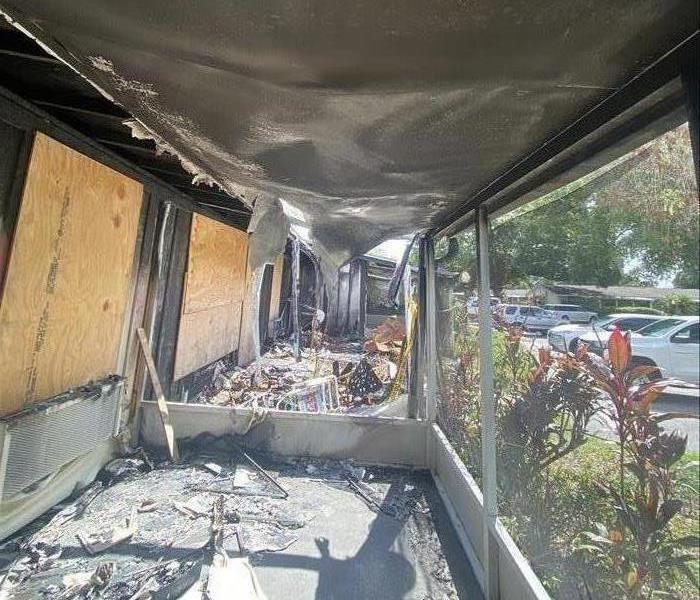 In this blog, we'll explore the main causes of bathroom mold, expert strategies for prevention, and effective removal techniques.
In this blog, we'll explore the main causes of bathroom mold, expert strategies for prevention, and effective removal techniques.
Bathroom mold is a common issue that many homeowners face in Florida. Due to the moisture-rich environment of bathrooms, they can be a prime breeding ground for mold growth. From unsightly discoloration on grout and tiles to the damage it can cause to walls and ceilings, bathroom mold is a serious problem that should not be ignored. In this blog, we'll explore the main causes of bathroom mold, expert strategies for prevention, and effective removal techniques to help keep your bathroom mold-free.
What Causes Mold in the Bathroom?
Mold thrives in areas where moisture and organic material (such as soap residue, dust, and skin cells) combine. Bathrooms, with their frequent exposure to water, warmth, and humidity, are an ideal environment for mold to develop. Here are the most common causes of bathroom mold:
- Excess Humidity: Bathrooms are naturally humid due to activities like showering and bathing. When humidity levels exceed 60%, mold spores can easily take root on damp surfaces like walls, ceilings, tiles, and even under sinks.
- Poor Ventilation: If your bathroom doesn’t have proper ventilation, moisture from showers and baths can become trapped in the room. This lingering moisture leads to condensation on walls and windows, creating the perfect breeding ground for mold.
- Leaky Fixtures: Mold can also develop when there are leaks from faucets, toilets, or pipes. Even a small, undetected leak can lead to significant moisture buildup, which, in turn, encourages mold growth behind walls, under flooring, or within cabinets.
- Soap Residue and Organic Debris: Soap scum, dirt, and other organic matter often accumulate on tiles, grout, and other surfaces. These materials provide mold with the nutrients it needs to grow.
How to Prevent Mold in the Bathroom
While mold is a common problem in bathrooms, there are several steps you can take to prevent its development. The key is controlling moisture and maintaining a clean environment. Here are expert tips for preventing bathroom mold:
- Ensure Proper Ventilation: One of the best ways to prevent mold is to ensure that your bathroom is well-ventilated. Install an exhaust fan and run it during and after showers or baths to help remove excess moisture. Keeping windows open can also help with air circulation, reducing the buildup of humidity.
- Use a Squeegee: After showering, use a squeegee to remove water from tiles, shower doors, and walls. This simple step can help reduce moisture and prevent mold from forming on wet surfaces.
- Fix Leaks Promptly: Regularly check your bathroom for leaks under the sink, around the toilet, or from the shower. If you notice any leaks, fix them immediately to prevent moisture from collecting in hidden areas.
- Use Mold-Resistant Products: When renovating or updating your bathroom, consider using mold-resistant paint, grout, and caulk. These materials are specifically designed to withstand the high-humidity environment of bathrooms and prevent mold growth.
- Reduce Humidity Levels: To further reduce humidity in your bathroom, consider using a dehumidifier, especially if you live in a humid climate. This can help keep moisture levels low, which in turn reduces the chance of mold growth.
How to Remove Mold from the Bathroom
If mold has already started to grow in your bathroom, it’s important to take swift action to remove it and prevent further growth. Here’s how you can effectively remove mold from your bathroom:
- Clean Surfaces Regularly: Regular cleaning is essential to keep mold at bay. Use a bathroom cleaner with mold-killing properties to scrub surfaces like tiles, grout, and shower doors. A mixture of vinegar and water can also work as a natural solution for cleaning mold.
- Remove and Replace Moldy Caulk or Grout: If mold has penetrated your caulk or grout, cleaning may not be enough. In such cases, it's best to remove and replace the mold-infested sections to prevent further spreading.
- Use a Mold Remover for Stubborn Areas: For more stubborn areas of mold, use a commercial mold remover designed for bathroom surfaces. Be sure to follow the manufacturer’s instructions and test the product on a small area first.
- Deep Cleaning with SERVPRO®: If the mold growth is extensive or if it's located in hard-to-reach areas, such as behind walls or under flooring, it's time to call in the professionals. SERVPRO offers specialized mold remediation services to safely and effectively remove mold from bathrooms and other parts of your home. Our experts use advanced equipment and cleaning solutions to ensure thorough mold removal, helping to prevent future growth.
The Importance of Early Detection
Catching mold early is key to minimizing damage and preventing it from spreading. According to the Environmental Protection Agency (EPA), mold can start to grow on wet surfaces within 24-48 hours. Regularly inspecting your bathroom for signs of mold and addressing leaks and moisture issues promptly can save you from costly repairs in the future.
Trust SERVPRO for Expert Mold Remediation
When it comes to bathroom mold, prevention and quick action are crucial. However, if mold becomes a persistent issue or spreads beyond your control, SERVPRO is Here to Help®. Our team of mold remediation experts is equipped with the knowledge, tools, and expertise to handle any mold problem, no matter how severe. We’ll work to not only remove the mold but also help you identify and address the root causes, ensuring your bathroom remains clean and mold-free.
With our professional services, you can trust that your bathroom will be restored to its original condition, allowing you to enjoy a clean and healthy space. Contact SERVPRO today for expert bathroom mold removal and remediation services.
Preventing bathroom mold requires vigilance and consistent moisture control. By following these expert tips, you can significantly reduce the chances of mold growing in your bathroom and keep your home safe from mold damage.
Is Your Home at Risk? What to Know About Flood Plains and Water Damage
10/14/2024 (Permalink)
 Whether you need advice on flood prevention or require water damage restoration services, SERVPRO of Temple Terrace is here to help.
Whether you need advice on flood prevention or require water damage restoration services, SERVPRO of Temple Terrace is here to help.
Living in Florida offers many benefits, but it also comes with the risk of flooding, especially if your home or business is located in a floodplain. Understanding the implications of being in a floodplain is crucial for protecting your property and ensuring you have the right insurance coverage. In this blog, we’ll explore what you need to know about floodplains, how they impact water damage risk, and steps you can take to protect your home.
What is a Floodplain?
A floodplain is an area of land adjacent to a river, stream, or other body of water that is prone to flooding. These areas are naturally low-lying and tend to collect water during heavy rains, storms, or hurricanes. In Tampa, many areas are designated as floodplains due to the region’s geography and proximity to water bodies like Tampa Bay and the Hillsborough River.
Understanding Flood Zones
Floodplains are categorized into different flood zones based on the likelihood of flooding. The Federal Emergency Management Agency (FEMA) designates these zones, and they play a significant role in determining your flood insurance requirements and premiums. For example:
- Zone A: High-risk areas where flooding is likely during a 100-year flood event.
- Zone B and C: Moderate- to low-risk areas where flooding is less likely but still possible.
- Zone V: Coastal areas at risk for storm surge in addition to flooding.
The Impact of Floodplains on Water Damage Risk
Living in a floodplain significantly increases your risk of experiencing water damage. Flooding can occur with little warning, and the damage can be extensive. Even a small amount of water can cause serious problems. According to FEMA, just one inch of water can cause up to $25,000 in damage to your home.
Insurance Considerations
If your property is in a high-risk flood zone, your mortgage lender will likely require you to have flood insurance. Even if it’s not required, it’s wise to consider purchasing flood insurance if you live in or near a floodplain. Standard homeowner’s insurance policies typically do not cover flood damage, so having a separate flood insurance policy is crucial for financial protection.
How to Protect Your Home in a Floodplain
While you can’t change your property’s location, there are several steps you can take to lower the risk of water damage if you live in a floodplain.
- Elevate Your Home
One of the most effective ways to protect your home from flooding is by elevating it above the base flood elevation (BFE). This reduces the likelihood of floodwaters entering your home and can also lower your flood insurance premiums.
- Install Flood Vents
Flood vents allow water to flow through your home’s foundation, reducing pressure and the risk of structural damage. These vents are particularly useful in preventing water buildup in crawl spaces and basements.
- Use Flood-Resistant Materials
If you’re renovating or building a new home in a floodplain, consider using flood-resistant materials. These materials are designed to withstand water damage better than standard building materials, reducing repair costs after a flood.
Protect Your Tampa Home from Flood Damage
Living in a floodplain in Florida comes with its share of risks, but by understanding them and taking proactive steps, you can protect your home from water damage. Whether you need advice on flood prevention or require water damage restoration services, SERVPRO of Temple Terrace is Here to Help®.
Battling Mold Growth in Florida: Effective Prevention and Treatment After Storms
9/11/2024 (Permalink)
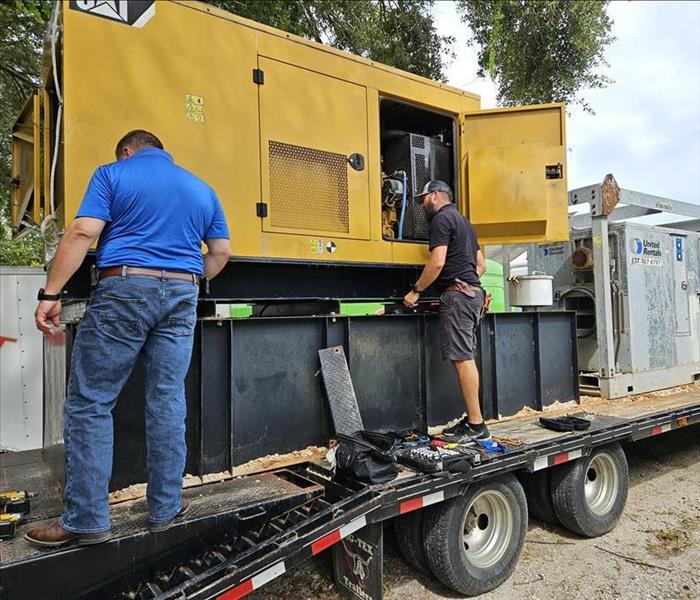 In this blog, we will discuss how to prevent and treat mold growth after storms in Florida.
In this blog, we will discuss how to prevent and treat mold growth after storms in Florida.
Florida's warm, humid climate and frequent storms make it a hotspot for mold growth, particularly after severe weather events. Mold can pose significant health risks and cause extensive damage to homes. In this blog, we will discuss how to prevent and treat mold growth after storms in Florida, and why professional help is often necessary for effective remediation.
Understanding the Mold Threat in Florida
Florida's environment is a breeding ground for mold because of high humidity and heavy rainfall. After a storm, water intrusion can quickly lead to mold growth if not addressed promptly. According to a study by the Environmental Protection Agency (EPA), approximately 50% of homes in Florida experience mold issues following severe storms. This statistic highlights the importance of immediate and thorough action to prevent mold from becoming a major problem.
Preventing Mold After a Storm
Preventing mold growth starts with swift action right after a storm. Here are key steps to take:
- Immediate Inspection and Drying: As soon as it is safe, inspect your home for signs of water damage. Utilize pumps and wet/dry vacuums to eliminate standing water. Employ dehumidifiers and fans to dry out affected areas thoroughly.
- Remove Damaged Materials: Wet carpets, furniture, and drywall can harbor mold spores and should be removed to prevent further growth.
- Clean and Disinfect: Clean hard surfaces with water and detergent. For non-porous materials, using a diluted bleach solution can be effective in killing mold spores.
- Ongoing Monitoring: Keep an eye out for signs of mold, such as musty odors or discoloration on walls and ceilings, even after initial cleanup.
Treating Mold Infestations
If mold has already taken hold in your home, it’s crucial to deal with it immediately to prevent health issues and structural damage:
- Prioritize Safety: Wear protective gear like gloves, goggles, and an N95 respirator to avoid exposure to mold spores.
- Containment: Seal off the affected area to prevent mold spores from spreading to other parts of your home.
- Removal and Disposal: Carefully remove mold-infested materials and dispose of them in sealed plastic bags.
- Thorough Cleaning: Use mold-specific cleaning solutions to scrub affected surfaces. For significant infestations, consider hiring professional remediation services.
Professional Mold Remediation
For extensive mold problems, professional remediation is often the best solution. SERVPRO® offers expert mold remediation services, using advanced techniques and equipment to ensure your home is safe and mold-free. The importance of professional help is underscored by the high incidence of mold problems in Florida homes post-storms, where immediate and thorough intervention can save thousands in potential damages.
Conclusion
Mold growth following storms is a significant issue for Florida homeowners. By taking swift preventive measures and seeking professional help when needed, you can protect your home and health from the detrimental effects of mold. Quick action and proper treatment are key to keeping your living environment safe and healthy.
SERVPRO is ready to assist with professional mold remediation services. Contact us today to learn more about how we can help with storm damage recovery and mold prevention in Florida.
Effective Strategies for Addressing Fire Damage in Multi-Unit Buildings
8/14/2024 (Permalink)
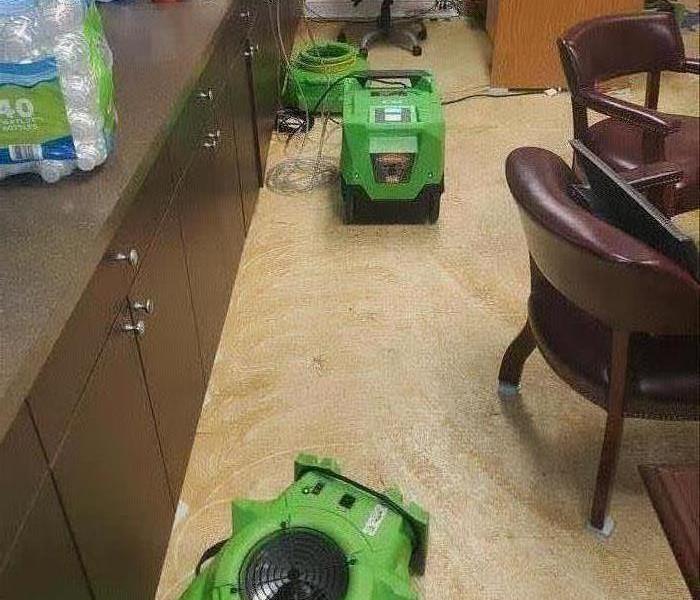 We'll share expert tips for addressing fire damage in multi-unit buildings, ensuring efficient and thorough restoration.
We'll share expert tips for addressing fire damage in multi-unit buildings, ensuring efficient and thorough restoration.
Fire damage in multi-unit buildings presents unique challenges. The interconnected nature of these structures means that damage can spread quickly, affecting multiple units and common areas. Quick, effective action is essential to mitigate damage and ensure the safety of all residents. In this blog, we'll share expert tips for addressing fire damage in multi-unit buildings, ensuring efficient and thorough restoration.
Immediate Safety Measures
Evacuate and Account for All Residents
The first priority after a fire is the safety of the building’s occupants. Ensure that all residents are evacuated promptly and accounted for. Work with emergency services to confirm that everyone is safe and that no one is left behind.
Secure the Building
Once the building is evacuated, it’s crucial to secure the premises. This involves sealing off the affected areas to prevent further damage and unauthorized access. Security measures protect the property and its contents from theft or vandalism during the restoration process.
Professional Assessment and Documentation
Conduct a Comprehensive Inspection
A detailed inspection by a professional restoration company, like SERVPRO®, is essential. Experts will assess the extent of the fire, smoke, and water damage. They use specialized equipment to identify hidden damage that might not be immediately visible.
Document the Damage
Thorough documentation is vital for insurance purposes. Take photographs and videos of all affected areas and compile a detailed inventory of damaged items. This documentation will support insurance claims and ensure you receive adequate compensation for the restoration work.
Effective Communication
Notify Residents and Stakeholders
Maintain open lines of communication with all residents and stakeholders. Inform them of the steps being taken to address the damage, the expected timeline for restoration, and any temporary relocation plans if necessary. Clear communication helps manage expectations and reduce anxiety among residents.
Coordinate with Insurance and Restoration Professionals
Work closely with your insurance company and restoration professionals to streamline the restoration process. Coordinated efforts ensure that the restoration work is completed efficiently and to a high standard, minimizing disruption to residents.
Restoration and Repair
Address Fire, Smoke, and Water Damage
Restoration involves addressing not just fire and smoke damage but also water damage from firefighting efforts. Professionals like SERVPRO use advanced techniques and equipment to clean, deodorize, and restore affected areas. This comprehensive approach ensures that all damage is treated effectively, preventing long-term issues such as mold growth.
Focus on Structural Integrity
In multi-unit buildings, ensuring the structural integrity of the entire building is critical. Restoration professionals will assess and repair structural elements to ensure the building is safe for occupancy. This includes checking electrical, plumbing, and HVAC systems for damage.
Prevention and Preparedness
Implement Fire Safety Measures
To prevent future incidents, implement robust fire safety measures. This includes installing smoke detectors, fire alarms, and sprinkler systems, and conducting regular fire drills. Educate residents about fire safety protocols to ensure they know how to respond in case of an emergency.
Develop an Emergency Plan
Having a well-defined emergency plan can significantly reduce the impact of a fire. Ensure all residents are familiar with evacuation routes and procedures. Regularly review and update the plan to address any changes in the building’s layout or occupancy.
Conclusion
Addressing fire damage in multi-unit buildings in Florida requires a coordinated, professional approach. By prioritizing safety, conducting thorough assessments, maintaining clear communication, and implementing effective restoration strategies, you can minimize damage and restore your property to its pre-fire condition. Trust SERVPRO for expert fire damage restoration services, ensuring the safety and well-being of all residents.
Understanding Mold in Your Attic: Causes and Effective Solutions
7/10/2024 (Permalink)
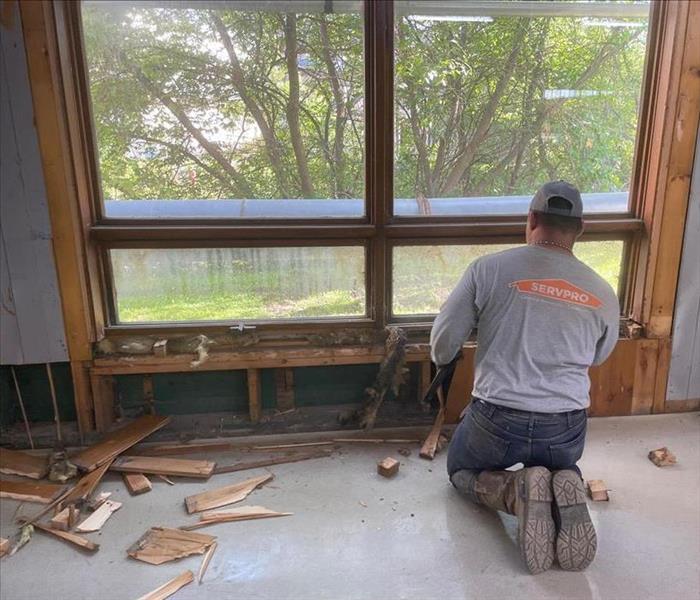 We delve into the causes of mold in your attic and provide practical solutions for preventing and remedying this issue.
We delve into the causes of mold in your attic and provide practical solutions for preventing and remedying this issue.
Mold growth in the attic is a common problem faced by many homeowners. The attic provides an ideal environment for mold to thrive, with its dark, warm, and often humid conditions. In this blog post, we'll delve into the causes of mold in your attic and provide practical solutions for preventing and remedying this issue.
Causes of Mold in the Attic
Poor Ventilation:
One of the primary causes of mold in the attic is poor ventilation. Inadequate airflow allows moisture to accumulate, creating a damp environment that promotes mold growth. Without proper ventilation, humidity levels in the attic can rise, especially during hot and humid weather.
Roof Leaks and Water Intrusion
Roof leaks and water intrusion are common culprits behind mold growth in the attic. A leaking roof, damaged flashing, or compromised seals around vents and chimneys can allow water to penetrate into the attic space. Even minor leaks can lead to significant moisture buildup over time, providing ideal conditions for mold to flourish.
Insufficient Insulation
Insufficient insulation in the attic can contribute to mold growth by allowing warm, moist air from the living space below to penetrate into the attic. When warm air meets the cooler surfaces of the attic, condensation can form, creating moisture that promotes mold growth on insulation, wood framing, and other materials.
Blocked Attic Vents
Blocked or inadequate attic vents can impede airflow and exacerbate moisture buildup in the attic. Blocked vents can result from debris accumulation, improper installation, or damage to the venting system. Without proper ventilation, moisture becomes trapped in the attic, creating an environment conducive to mold growth.
Solutions for Mold in the Attic
- Improve Attic Ventilation: Address poor ventilation by installing additional vents or improving existing ventilation systems in the attic. Ridge vents, soffit vents, gable vents, and attic fans can help promote airflow and reduce moisture buildup.
- Repair Roof Leaks and Water Intrusion: Address any roof leaks or water intrusion issues promptly to prevent further moisture infiltration into the attic. Repair damaged roofing materials, flashing, and seals to ensure a watertight barrier against the elements.
- Upgrade Attic Insulation: Improve attic insulation to prevent warm, moist air from entering the attic space. Proper insulation helps maintain consistent temperatures and reduces the risk of condensation and moisture buildup that can lead to mold growth.
- Clear Attic Vents and Ensure Proper Maintenance: Regularly inspect and clean attic vents to ensure they are free from debris and obstruction. Trim overhanging branches, remove leaves and debris, and repair damaged vents to maintain proper airflow in the attic.
Mold growth in the attic can be a persistent and concerning issue for homeowners. By understanding the causes of mold in the attic, such as poor ventilation, roof leaks, insufficient insulation, and blocked vents, you can take proactive measures to prevent mold growth and protect your home. Implementing solutions such as improving attic ventilation, repairing roof leaks, upgrading attic insulation, and ensuring proper maintenance of attic vents can help mitigate the risk of mold in your attic and maintain a healthy indoor environment. If you require assistance with mold remediation or attic restoration, contact a professional restoration company like SERVPRO® for expert assessment and remediation services.
Salvaging Water-Soaked Artwork: Restoration Techniques
6/20/2024 (Permalink)
Water damage can wreak havoc on precious artwork, causing irreversible harm to paintings, photographs, and other valuable pieces. Whether the damage is caused by flooding, leaks, or burst pipes, prompt action is crucial to salvage water-soaked artwork and prevent further deterioration. In this blog, we'll explore restoration techniques used to salvage water-damaged artwork, preserving its beauty and cultural significance.
Assessing the Damage
Before beginning the restoration process, it's essential to assess the extent of the damage and identify the type of artwork affected. Different materials and mediums require specific restoration techniques to ensure the best possible outcome. Here are some common types of water-damaged artwork and their restoration considerations:
- Paintings: Water can cause paint to run, warp canvas, and promote mold growth. Paintings on canvas may require professional cleaning, re-stretching, and retouching to restore their original appearance.
- Photographs: Water can cause photographs to stick together, fade, or develop mold. Professional photo restoration techniques may involve carefully separating damaged photographs, cleaning, and digitizing to preserve the images.
- Paper-Based Art: Water-soaked paper can warp, tear, or become discolored. Restoration techniques for paper-based art may include air drying, flattening, and deacidification to stabilize and preserve the paper.
- Sculptures and 3D Art: Water damage to sculptures and three-dimensional artwork can result in warping, cracking, or surface deterioration. Restoration may involve cleaning, repairing, and refinishing the affected surfaces.
Restoration Techniques
- Drying: The first step in restoring water-damaged artwork is to dry it thoroughly. Air drying is often the safest method for delicate pieces, while dehumidifiers and fans can expedite the drying process. Avoid applying heat, as it can cause further damage to sensitive materials.
- Cleaning: Once the artwork is dry, it may require cleaning to remove dirt, mold, and other contaminants. Professional conservators use specialized cleaning solutions and techniques to safely clean delicate surfaces without causing further damage.
- Consolidation: For paintings on canvas or paper, consolidation techniques may be used to re-adhere flaking or detached paint or paper layers. Conservators apply a consolidant solution to stabilize the artwork and prevent further deterioration.
- Deacidification: Paper-based artwork that has been exposed to water may become acidic, leading to deterioration over time. Deacidification treatments neutralize acidity and help preserve the integrity of the paper.
- Retouching and Inpainting: In cases where paint or image layers have been damaged, retouching and inpainting techniques may be used to recreate lost details and restore the artwork's original appearance. These techniques require a skilled hand and a deep understanding of the artwork's original style and composition.
Prevention Tips
Prevention is always the best approach to preserving artwork and avoiding water damage. Here are some tips to protect your artwork from water-related incidents:
- Display artwork in climate-controlled environments with stable humidity levels.
- Avoid hanging artwork in areas prone to water leaks or flooding, such as basements or near plumbing fixtures.
- Install leak detection systems and address any plumbing issues promptly to prevent water damage.
- Keep artwork properly framed and sealed to protect it from moisture and environmental contaminants.
Water damage can pose a significant threat to precious artwork, but with proper restoration techniques, many pieces can be salvaged and restored to their former glory. Professional conservators have the knowledge, skills, and tools necessary to safely restore water-damaged artwork while preserving its cultural and aesthetic value. By taking swift action and employing appropriate restoration techniques, you can protect your artwork from the devastating effects of water damage and ensure its longevity for future generations to enjoy.
Weathering the Storm: Essential Tips for Commercial Storm Damage Preparedness
5/10/2024 (Permalink)
As a business owner, safeguarding your commercial property against the potential ravages of severe weather is essential for continuity, safety, and peace of mind. From hurricanes and tornadoes to heavy rainstorms and blizzards, preparing for the unexpected can minimize damage and downtime in the aftermath of a storm. In this blog, we'll discuss crucial tips for commercial storm damage preparedness, ensuring your business remains resilient and ready to weather any storm that comes its way.
Develop a Comprehensive Emergency Plan
Begin by creating a detailed emergency plan that outlines procedures for staff evacuation, communication protocols, and post-storm recovery efforts. Ensure all employees are familiar with the plan and conduct regular drills to practice emergency procedures.
Secure Important Documents and Data
Safeguard important documents, financial records, and electronic data by storing them in waterproof containers or backing them up digitally. In the event of water damage or structural compromise, having access to critical information can expedite recovery efforts.
Perform Regular Maintenance Checks
Conduct routine inspections of your property to identify and address any structural vulnerabilities, such as loose roofing materials, damaged windows, or clogged drainage systems. Prompt maintenance can prevent minor issues from escalating into major problems during a storm.
Reinforce Doors and Windows
Strengthen the integrity of your building by reinforcing doors and windows with storm shutters, impact-resistant glass, or protective coverings. These measures can minimize the risk of wind-driven debris causing damage to your property's exterior.
Invest in Backup Power Systems
Install backup power systems, such as generators or uninterruptible power supplies (UPS), to keep essential equipment and systems operational during power outages. This ensures uninterrupted business operations and minimizes disruptions to critical services.
Secure Outdoor Assets and Equipment
Anchor outdoor equipment, signage, and furniture to the ground to prevent them from becoming projectiles during high winds. Consider relocating vulnerable assets indoors or securing storage areas before an impending storm.
Establish Communication Channels
Maintain open lines of communication with employees, customers, and suppliers before, during, and after a storm. Utilize multiple communication channels, such as email, text messaging, and social media, to disseminate important updates and instructions.
Partner with a Trusted Restoration Company
Establish a partnership with a reputable restoration company like SERVPRO® to expedite cleanup and recovery efforts in the aftermath of a storm. Having a trusted partner on standby can mitigate damage and reduce downtime, allowing your business to resume operations swiftly.
By implementing these tips for commercial storm damage preparedness, business owners can fortify their properties against the unpredictable forces of nature and minimize the impact of severe weather events. From proactive maintenance and reinforcement measures to robust emergency planning and partnerships with restoration experts like SERVPRO of Temple Terrace, investing in storm preparedness is an investment in the resilience and continuity of your business.
Safeguarding Success: The Critical Importance of Fire Alarm Systems in Commercial Buildings
4/16/2024 (Permalink)
In the dynamic landscape of commercial spaces, where bustling activity and valuable assets converge, the importance of fire safety cannot be overstated. Fire alarm systems play a pivotal role in protecting not only property but, more importantly, the lives of those within. In this blog, we'll delve into the crucial significance of fire alarm systems in commercial buildings and how they contribute to a comprehensive fire safety strategy.
Early Detection and Rapid Response
Fire alarm systems act as vigilant sentinels, designed to detect smoke or heat anomalies at the earliest stages of a fire. Early detection allows for a swifter response, giving occupants precious moments to evacuate and emergency services to intervene promptly.
The primary function of fire alarm systems is to provide immediate alerts. The piercing sound of an alarm serves as a universal signal to evacuate, ensuring that everyone within the commercial building is aware of the potential danger.
Protecting Occupants and Visitors
Commercial buildings are dynamic environments with varying levels of occupancy. Fire alarm systems are essential for safeguarding the diverse array of people within these spaces, from employees and clients to visitors and contractors.
Beyond the protection of lives, fire alarm systems are crucial for minimizing property damage. Early detection enables a faster response from firefighting services, helping to contain and extinguish the fire before it can escalate and cause extensive destruction.
Compliance with Regulations
Adherence to fire safety regulations is mandatory for commercial buildings. Fire alarm systems are a fundamental component of compliance, ensuring that businesses meet the standards set by local authorities and regulatory bodies.
Fire alarm systems can be seamlessly integrated with other emergency systems, such as sprinklers and emergency lighting. This interconnected approach enhances the overall effectiveness of emergency response plans.
Reduction of Insurance Costs
Many insurance providers recognize the importance of fire safety measures. Commercial buildings equipped with robust fire alarm systems may enjoy reduced insurance premiums as a testament to their commitment to risk mitigation.
In expensive commercial structures, a fire could go unnoticed without an effective alarm system. These systems are designed to cover vast areas, ensuring that any potential fire is detected promptly, regardless of its location.
Mitigation of Business Disruption
Fires not only pose a threat to lives and property but can also disrupt business operations. Swift detection and intervention facilitated by fire alarm systems help minimize downtime and preserve business continuity.
Investing in a robust fire alarm system is an investment in the safety and well-being of everyone connected to a commercial building. Beyond compliance and cost considerations, these systems are a testament to a proactive approach to safety, reflecting a commitment to the protection of lives and property. In the unpredictable landscape of emergencies, fire alarm systems stand as stalwart guardians, ready to alert, protect, and ensure the continued success of commercial endeavors.
Mold vs. Mildew: Unveiling Their Distinct Traits
2/6/2024 (Permalink)
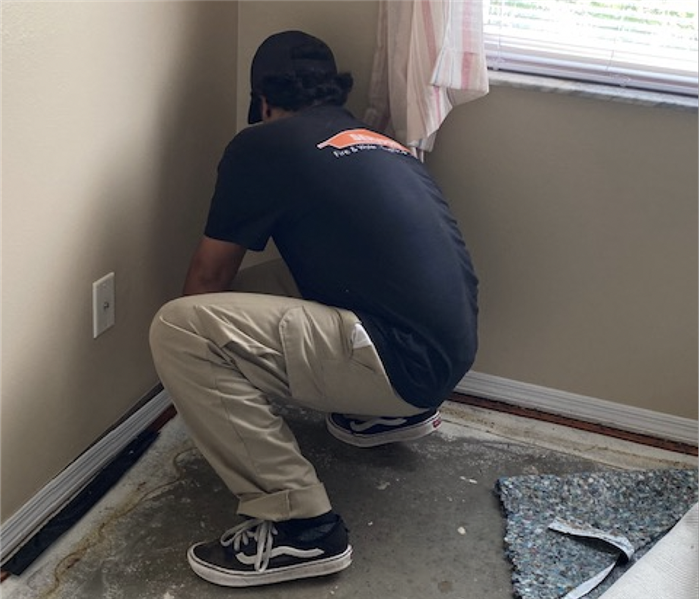 In this blog, we'll unravel the mystery behind mold vs. mildew, shedding light on their distinct characteristics and the best ways to deal with them.
In this blog, we'll unravel the mystery behind mold vs. mildew, shedding light on their distinct characteristics and the best ways to deal with them.
Mold and mildew have a knack for showing up unexpectedly in your home and making themselves at home on various surfaces. Although they might seem similar at first glance, understanding the differences between mold and mildew is crucial for effective removal and prevention. In this blog, we'll unravel the mystery behind mold vs. mildew, shedding light on their distinct characteristics and the best ways to deal with them.
Appearance
Mold comes in various colors, including green, blue, or black, and its appearance can be fuzzy or slimy, depending on the type. It tends to have a more textured appearance, resembling spots or patches that can be raised or have a fuzzy texture.
On the other hand, mildew is typically white or gray, with a powdery appearance. It can also manifest in shades of yellow or brown, depending on the surface it infests. Mildew usually has a flat or powdery texture, giving affected surfaces a more downplayed and less invasive look.
Surface Growth
Mold tends to penetrate surfaces, growing not only on the surface but also beneath it. This makes it more challenging to eradicate. Mold thrives in damp and humid environments, making it more likely to appear on materials like wood, drywall, or fabrics.
In contrast, mildew typically stays on the surface without penetrating deeper layers. This makes it relatively easier to clean and remove. Mildew favors flat, non-porous surfaces like bathroom tiles, shower curtains, or painted walls.
Environmental Preferences
Mold thrives in environments with higher moisture levels, often caused by persistent water issues, leaks, or high humidity. It is versatile and can adapt to a wide range of temperatures, making it resilient in various indoor and outdoor settings.
Mildew prefers high humidity but can also thrive in lower humidity conditions. It often appears in areas with limited ventilation or inadequate airflow. Mildew is more surface-specific and tends to grow on materials like shower tiles, fabrics, or paper.
Removal Methods
Mold removal often requires thorough cleaning, including the removal of affected materials in severe cases. Professional intervention may be necessary for extensive mold growth. Addressing the root cause, such as water leaks or humidity issues, is crucial for preventing mold recurrence.
Mildew can often be cleaned with surface disinfectants or household cleaning agents. Regular cleaning and maintenance can help prevent mildew growth.
Understanding the differences between mold and mildew empowers homeowners to address these uninvited guests with the right approach. Whether it's the textured appearance of mold or the powdery nature of mildew, recognizing these nuances is key to effective removal and prevention strategies. Regular cleaning, proper ventilation, and addressing moisture issues are crucial for keeping both mold and mildew at bay in your living space.
 Explore the benefits of professional upholstery cleaning after a fire and why it’s essential for your home’s recovery.
Explore the benefits of professional upholstery cleaning after a fire and why it’s essential for your home’s recovery.

 24/7 Emergency Service
24/7 Emergency Service





